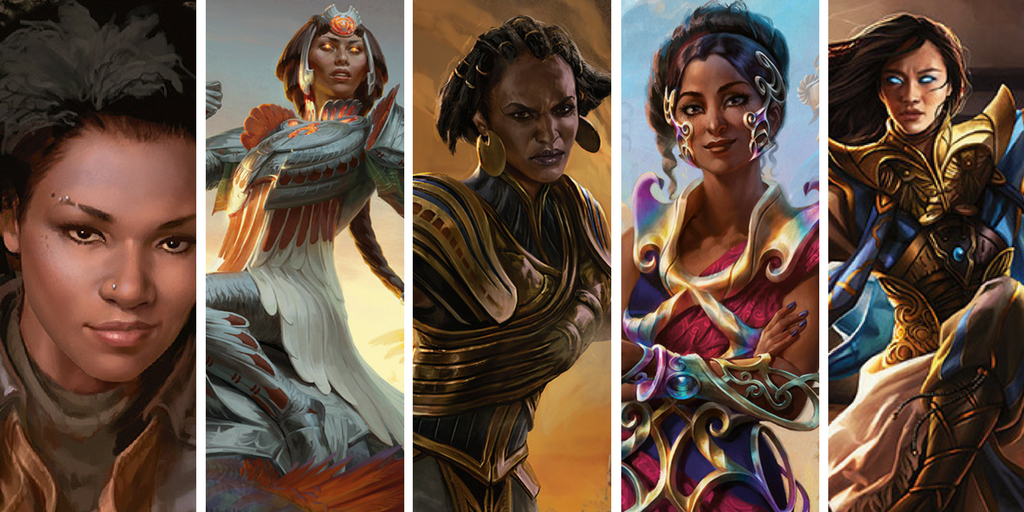Disclosure: These are my opinions as a free agent and separate entity from Magic: The Gathering.
As you might know, I acted as as consultant for Magic: The Gathering for the development of their first black Planeswalker character, Kaya, Ghost Assassin. (For info on what a Planeswalker is and what Kaya does, check this post.) Recently, I was able to recount my experiences with Magic: The Gathering in my first post for SyFy Wire, a year after Kaya made her big debut.
I’ve been excited by what Magic: The Gathering is doing, especially with regard to the sensitivity being shown players of color, specifically women of color. Women of color don’t get much thought put towards them in gaming overall, so it’s nice to see a company put their best foot forward in an attempt to get it right. What’s also great is that they admit when they’ve had shortcomings. That shows a willingness to learn that other gaming companies should adopt.
The big question on every fan’s lips is when will Kaya pop back up on the scene. I’ll quote what Magic writer (and my Kaya partner) Kelly Digges said in my SyFy interview with him:
Well, I can’t answer questions about the future, but I can tell you that she is on our very short-list of characters to bring back in the immediate future. You haven’t seen the last of Kaya and I’m very excited for people to see her again as soon as possible.
In the meantime, I’ve wanted to turn Magic newbies and folks who are old hat at Magic to five of the company’s women of color. Whilst I’m sure there are more characters coming down the line, these five are a solid starting lineup for anyone’s WOC-centric deck.
Kaya, Ghost Assassin
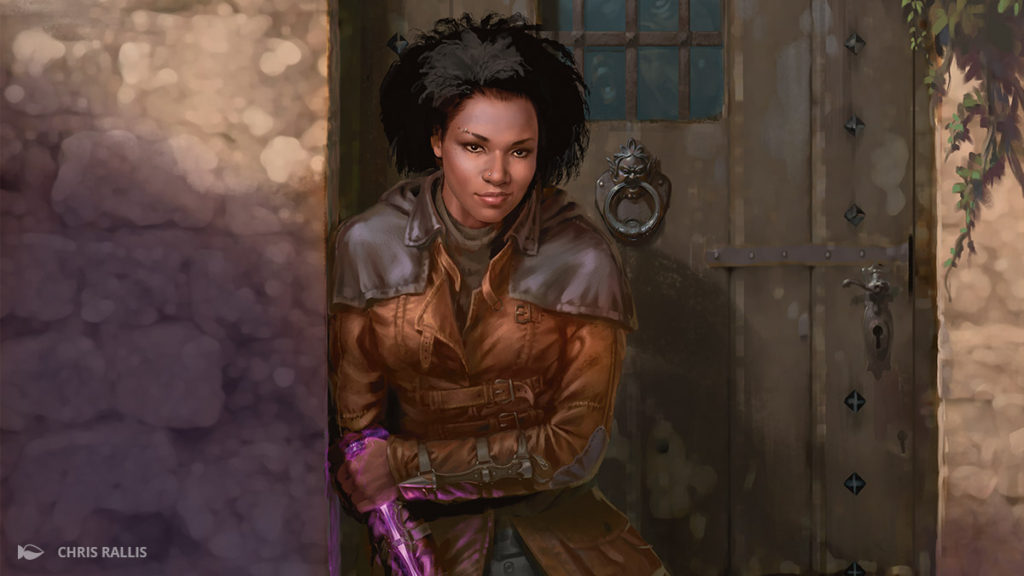
Kaya’s official bio, via Magic:
A confident, roguish duelist with a mysterious past, Kaya has the ability to become partially incorporeal—allowing her to slip through solid items and physically interact with ghosts and the spirit world.
Kaya is a firm believer that life is for the living. The living should make the most of their lives and pursue what they want while they’ve still got time, and find their own peace before death. If you die with unfinished business, well, that’s probably your fault. And if it’s not…perhaps she could help you…for a price.
In Paliano, she accepted a contract from Marchesa to assassinate the city’s previous sovereign, King Brago. Her actions catapulted Marchesa to power and caused the current chaos in the city—but also opened the way for others to make their claims to their throne and shake up the Paliano’s ancient political order.
How much more do I need to say about my character? If you’ve been here before, you read a lot of words on her already, so y’all already know she’s awesome. However, if you’re new to Kaya, here’s the short of it–she’s a mysterious gun-for-hire who exterminates ghosts who remain on this living plane with her own ghostly powers. As Kelly said in the interview, she was originally nicknamed “Hanna Solo” by the development team, which gives you a good indication as to her personality and how she carries herself in battle and in everyday life. She’s just cool, and she’s only made cooler by the fact that I helped develop her. Believe me when I say there are a lot of tricks up this character’s sleeve. Have you seen all of them? Well…
Huatli
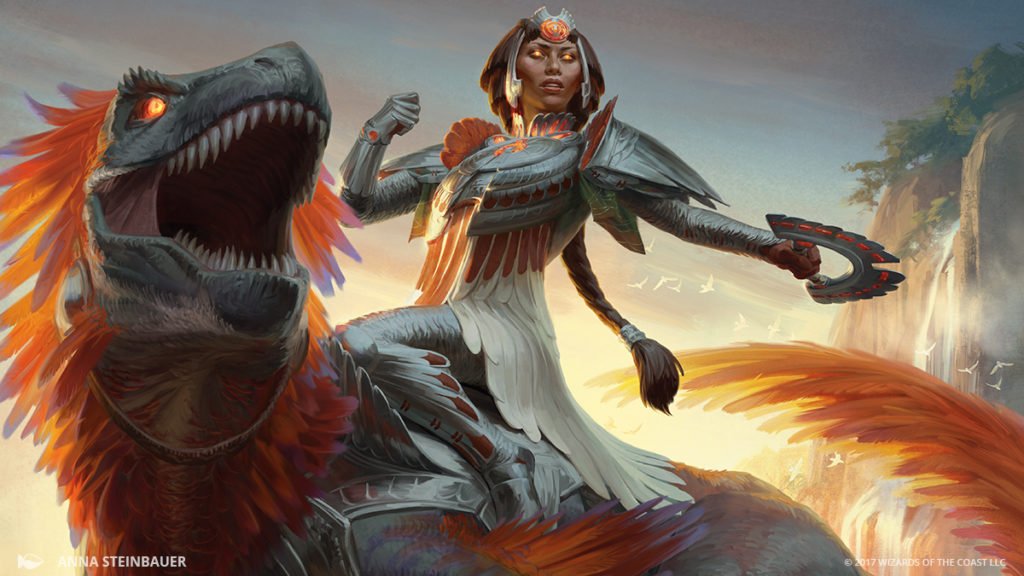
Huatli’s bio, via Magic:
Huatli was raised in the Sun Empire. Thanks to her martial skill and talent as an orator, she rose to a station just short of nobility. The course of her life changed during one such raid, when she confronted a terrifying beast—the minotaur pirate Angrath the Flame-Chained. An incredibly powerful foe, he pressed her to the limit of her abilities. At the moment of her greatest desperation her planeswalker spark ignited. She saw a glimpse of a faraway place, but was suddenly yanked back to where she began. Inexplicably, Angrath failed to press his advantage and instead withdrew, leaving her to contemplate her experience. Under instruction from her Emperor, Huatli adventures to locate the Golden City and secure her title as Warrior-Poet of the Sun Empire.
The Meso-American plane of Ixalan is where we meet Huatli, and I’m really excited for her addition into the Magic: The Gathering world. I believe she’s the first Latinx/Indigenous character for Magic, and it’s great to see them expanding into more realms of representation. What I think is so cool about Huatli, representation nods aside, is that she’s a Planeswalker who rose up the ranks on her plane due to her poetry. There aren’t a lot of characters nowadays, in gaming or other modes of media, that become lauded because of their artistic skill. Showing younger players that there is merit in expressing yourself through your talents can only result in more positivity and higher self-esteem in these kids’ lives, particularly since it’s all too common for folks to think that there aren’t any reasons to pursue a talent to its highest height. Also, she’s riding a dinosaur as her steed. You can’t get cooler than that.
She’s a massive hit with the fans–as are all of these characters in this article. I’m thrilled that there are so many fans who have rallied around Huatli and her world; their interest in her and her culture shows what inclusion can do–through Huatli, some young kid (or adult) might decide they want to learn more about the Mayans and other indigenous cultures to Mexico and Latin America. Who knows; Huatli could spark the next wave of historians, archaeologists, and cultural experts. The ability to positively shape and enrich someone’s life is really where the power and responsibility in storytelling lies.
Samut
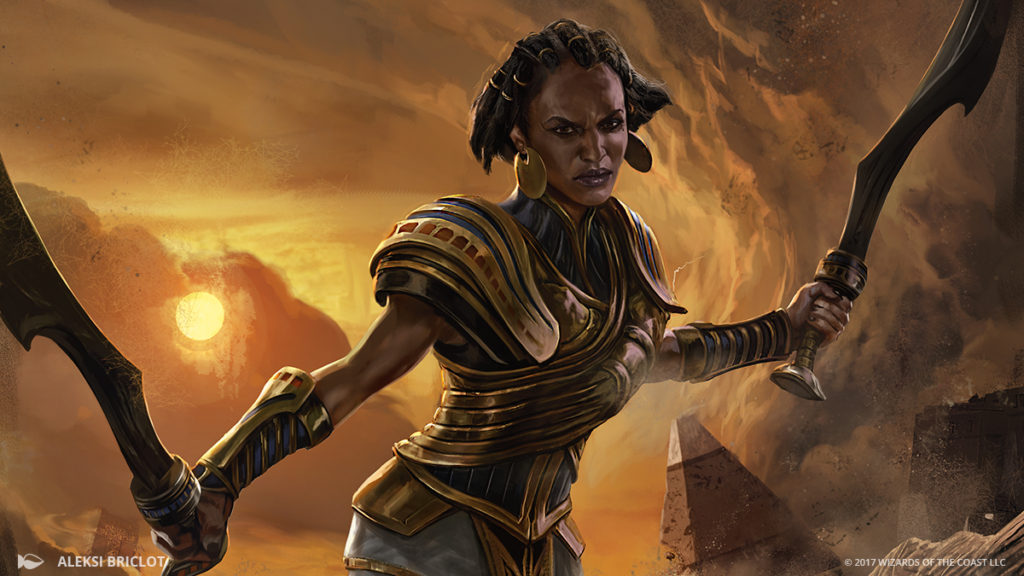
Samut’s bio, via Magic:
Samut was a renowned initiate, a master of the double khopesh, and adept at channeling her speed and strength into her attacks. She was a leader among her crop, and was highly dependable during battle. Fellow crop members reported that it seemed she was always everywhere at once; she had everyone’s back, and never let a fellow fall. Her speed seemed inhuman, as did her ability to strike down opponents to protect her crop. She and her close friend Djeru were unstoppable among the initiates.
But Samut had a secret. As a child, she ventured outside of the magical barrier that protected her city, and discovered evidence of a not-so-distant past. She found hieroglyphs of long-forgotten dances and rituals on the walls of ancient buildings, and determined that something had altered her world to its core. Samut studied the dances and learned as much as she could about Amonkhet’s past, and vowed to reveal the truth about what had happened to Amonkhet. She grew up to be a persistent and determined adult, but was uncertain how she alone could make the change she needs. For that reason, she prevented the death of her friend Djeru and resolved to convince him to help her rally their people and their beloved gods against the God-Pharaoh.
Samut comes from the ancient Egypt-adjacent plane called Amonkhet. Again, like with Huatli and Ixalan, Samut and Amonkhet could propel a Magic-loving kid to want to study ancient Egypt, leading them to a journey of discovery, cultural acceptance, and love of learning.
This particular plane, including Nicol Bolas’ effect on the plane, could also lead players to study more about Afrofuturism, an art and literary movement that seeks to put black characters and pan-African cultures at the center of their own destiny–in this case, it’s argued that race and the concept of “blackness” will cease to be seen as a negative factor once blackness is taken out of its American, Westernized, white supremacist-laced meaning. The genre offers a chance for black characters to represent the humanity of the black diaspora. I get into that a little in my little segment in Mike Linnemann’s Gathering Magic article about Amonkhet.
To speak to her character, Samut can teach players, particularly those of the younger set, to stay inquisitive and follow your gut instinct; if you feel something’s not right, don’t let others tell you you’re wrong. Find out why you feel a certain way–investigate and never take “no” for an answer. Samut’s story might be even more salient during this current political time, where 1984′s double-think and double-speak are now real modes of policy. Almost everyone in Amonkhet is bewitched to think that Nicol Bolas is the supreme god, and anyone who objects goes missing. Samut is one of the few who can see beneath the illusion, and she’s risking her life to save her people. Sometimes telling the truth–and fighting for it–can seem dangerous. But the lesson Samut teaches is that it’s always best to fight for what’s right.
Saheeli Rai
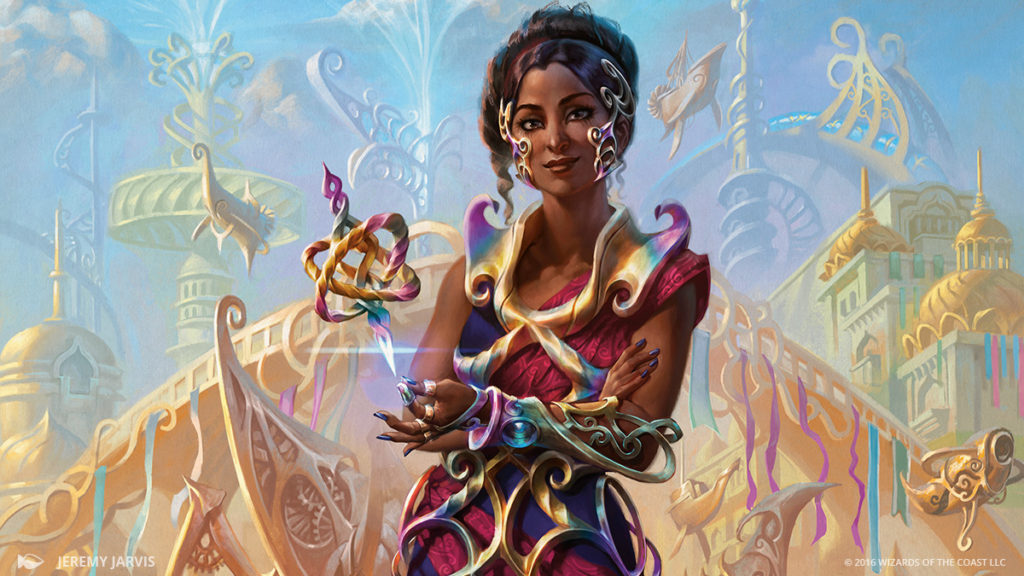
Saheeli’s bio via Magic:
On her home plane of Kaladesh, Saheeli is a famous inventor renowned as the most brilliant metalsmith of her time. She’s best known for the bewitchingly lifelike artifact constructs she crafts out of gleaming iridescent metal. From the smallest insect to the largest elephant, Saheeli has an uncanny ability to replicate any creature she sees, capturing the essence of its life in her metal creation. Admirers, collectors, and investors flock to see her designs, spending hours gazing, enraptured by her artistry.
Her innate, effortless talent has made her the envy of many fellow inventors, especially lifecrafters who look to her both for inspiration and as a formidable rival. Saheeli doesn’t shy away from competition; when it comes to defending her hard-earned reputation, she is fiercely cutthroat. But when not in contest, she’s wholly supportive of the efforts of other inventors, happy to share advice, a kind word, or an encouraging smile. She thrills at the prospect of innovation, and basks in the creative spirit that surrounds her in Ghirapur. Her bright, optimistic personality draws others to her, and her genuine, thoughtful nature resonates with her fans, who hail from all corners of Kaladesh.
Saheeli’s talents extend beyond what the people of Kaladesh realize or understand. She’s a Planeswalker with a powerful magical command over metal. She can access seemingly endless threads of metal, which she can then weave into one of her creations. And once created, Saheeli’s magic allows her to compel her metal constructs to do her bidding. Thanks to her abilities, she’s never at a loss for an artifact companion.
As I wrote in my post last year about Saheeli, she is (from what I know) the first Planeswalker from South Asian heritage. From what I’ve seen and researched, there hasn’t been another Planeswalker that has focused on South Asian representation. Here’s what Magic had to say about their design process.
To help us treat our cultural references with respect and care, we enlisted help from a team of Indian colleagues at Wizards, including Jisi Kottakuzhiyil, Sandeep Kedlaya, Narayanan Raghunathan, Sathish Ramamurthy, Basha Mohideen, and Trinadh Nemaniat. With their guidance throughout multiple phases of our process, we honed aspects of the world—from the look of a field in a basic Plains to the visuals for the races on the plane to the phonemes in names—to try to reflect Indian inspirations in Kaladesh. They oversaw our progress throughout the concept push all the way through to reviewing art that appears in the card set. They let us know what they found exciting and what were points to avoid. They guided us toward what they felt was an interesting mixture of elements from Northern and Western India in the patterned rhinoceros mount of Armorcraft Judge, and cautioned us against the use of colors or shapes with strong religious connotations, including saffron-colored robes or green domes in architecture.
What’s also empowering is that she’s a creator who lives on innovation. From women in STEM to women who make a living as artists, innovation is key, and a love for innovation is something that should be fostered in the young, especially girls, who are often taught that being different–in looks, mannerisms, behavior and interests–is unacceptable. With Saheeli as an inventor herself, she could become a role model to other girls who see themselves as inventors, too. Who knows? Our next big tech mogul could have well-worn Saheeli card in her pocket.
Narset
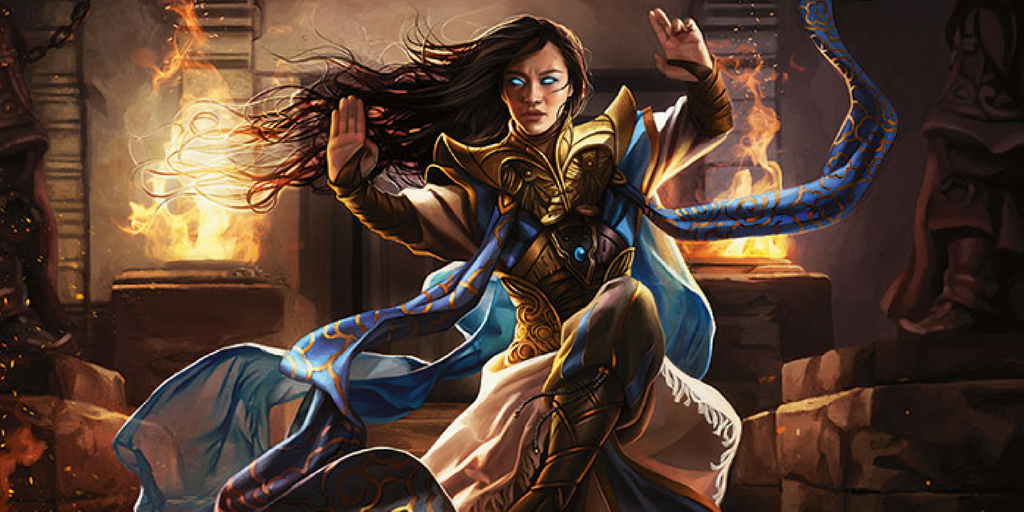
Narset’s bio, via Magic:
In a world where history unfolded differently, Narset was the khan of the Jeskai, a clan of warrior monks. She seemed on the cusp of enlightenment, but her true potential remained latent, untapped. In this timeline, she is one of the foremost scholars of Tarkir’s history-and a Planeswalker.
At a young age, Narset gained the personal notice of one of Ojutai’s skywise. She attracted the dragon’s attention as she would often mimic the exercises performed by both the dragons and her elders, mastering them after no more than a casual glance. The skywise recognized hers as a mind with the potential for nearly limitless growth, so she was taken on as a student. Narset quickly mastered not only the exercises but the Draconic language itself, and over the following years she became one of the youngest of the clan to learn directly from Ojutai. But as Narset grew older she began to feel restless. She harbored a longing, although she was unable to identify what for, and she started to question whether or not the skywise dragons truly knew all the answers to the questions of life.
When, in relatively short order, Narset achieved the status of master, she cared more for the autonomy that the position granted than the highly sought-after honor. She spent many a day alone, exploring the deepest and dustiest cavities in the Ojutai strongholds, slowly piecing together clues that illuminated the forbidden past. Her peer, Taigam, warned her of the danger in seeking out knowledge without the dragonlord’s permission, but Narset saw no harm in research.
She discovered the truth of the past of Tarkir. It was not always a world ruled by dragons as the teachings of Ojutai claimed; at one time humanoid khans led mighty clans that dominated the land. Narset also learned of a powerful spirit dragon from whom all dragons were formed. It was this being that most interested her. She could feel something more in the histories that described him, something similar to her own wanderlust. She took to meditating in these secret chambers, spending hours that crept into days and even weeks without making an appearance above.
Now that her Planeswalker spark has ignited, she has the ability to walk the Blind Eternities, the space between planes, and discover new worlds, but her devotion is to her home plane of Tarkir. Narset knows that the mysterious past might hold the key to long-lost magic, power that might not just benefit her clan, but the whole of Tarkir. So she carefully and painstakingly continues her research. She will wait, ever patient, for her time.
Narset’s world clearly harkens back to ancient China and Mongolia, a time that extends through so many leaders and Imperial eras that, as a kid, I had to learn more about it. Since I was so big into Indian and Chinese history as a kid, a character like Narset would have been my gateway to learning more (if she was around when I was a kid, that is).
What I also love is that she’s drawn to her Planeswalker abilities through her endless pursuit of knowledge and her quest to find the truth of life. Questioning is something we should all make a practice of–questioning why the status quo is what it is, and what we can do to enrich ourselves and others. The ability to learn is something we all have, but the willingness to learn–the willingness to upset our own internal equilibrium in order to become more complete versions of ourselves–is something that takes a specific type of bravery. Narset’s ever-long quest to find out more about the universe is reflective of her unique spirit.
Loved this article? Follow JUST ADD COLOR on Twitter, Instagram, and Facebook!
